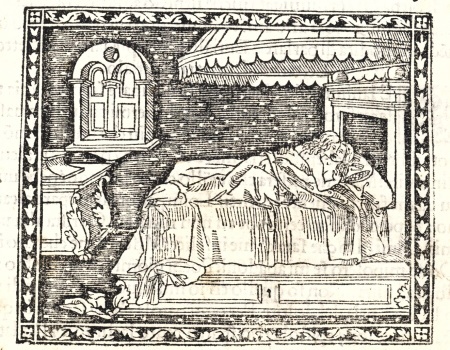Throughout its history, the papacy has had its fair share of reprobates. At least Pope Pius II dallied from the straight and narrow before he was ordained, let alone pope. As a literati of his time, he even wrote a bestselling erotic novel.
Enea Silvio Piccolomini (“Aeneas Silvius” in the Latin used by the educated) was born in the Tuscany region of Italy in 1405. By age 25 he made a career of working for Catholic bishops and cardinals. Those positions, though, didn’t quell his lustier side. As the Catholic Encyclopedia puts it, “That he freely indulged his passions is evidenced not only by the birth of two illegitimate children …, but by the frivolous manner in which he glories in his own disorders. The low moral standard of the epoch may partly explain, but cannot excuse his.” In fact, the encyclopedia notes, Aeneas avoided ordination until he was 41 “because of the obligation of [sexual] continence that it imposed.”

Illustration from Tale of Two Lovers
Aeneas’s intelligence and literary talents were such that Frederick III of Austria (1415–93) invited him to Vienna in 1442 as his private secretary and imperial poet laureate. He wrote some “mildly pornographic poetry” during that time, according to papal historian John Julius Norwich. Aeneas’s literary reputation led a fellow Tuscany native to ask him to write a story about two lovers. The result was 1444’s Tale of the Two Lovers, a suggestive tale about the secret love affair between Lucretia, a married woman of “barely twenty”, and Euryalus, a 32-year-old man in waiting for Frederick III.
Lucretia and Euryalus first see each other at a funeral in Siena, Italy. They were not introduced “but their eyes did everything.” It was love at first sight but both wondered if their love was unrequited. They end up exchanging a series of letters before and after consummating their love affair, leading some to suggest Tale of Two Lovers was the first epistolary novel or at least a significant step in its development.
Numerous manuscripts of the story circulated but it wasn’t published until after the pope died in 1464. That came between 1467 and 1470 at the hands of Cologne’s first printer, Ulrich Zell. The book became a bestseller. There were 67 printed editions by the end of the 15th century and about 40 more in the 16th century. Erotic images in some of the early editions may well have increased the book’s popularity.
In 1445, Aeneas left Vienna and he was ordained in March 1446. He was named a cardinal in December 1456 and installed as Pope Pius II on September 3, 1448. His literary activity continued while the pope and following his death the 13-volume Commentaries of Pius II was published, the only known autobiography of a pope. Recognizing his earlier conduct and literary efforts weren’t betting the Vicar of Christ, he distanced himself from Tale of Two Lovers as Pope Pius II. In an April 1463 papal bull some call the “Bull of Retraction,” the pope told the rector and students of the University of Cologne that he was ashamed, repented his early writings, and wished them to obscurity. “Follow what we now say: believe the old man rather than the youth,” he wrote, “reject Aeneas, accept Pius.”
The number and success of the printed editions of Tale of Two Lovers show his wish for obscurity wasn’t realized.
Gladly, Euryalus, would I yield to you, and, as you request, admit you to my love.
Enea Piccolomini, Tale of the Two Lovers







